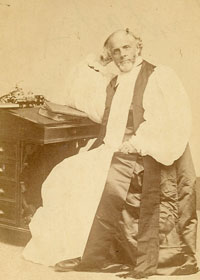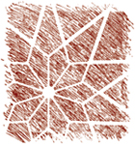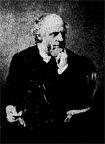- Our first chapel was built.
- Transepts were added to the nave.
Timeline of History at Emmanuel
1862
- April 24. Emmanuel Church consecrated. It was the first building constructed on Newbury Street.
- Pew deeds were issued.
- Edward Payson Dutton became clerk.
1861
 March 24. The Rev. Dr. Frederic Dan Huntington (May 28, 1819-July 11, 1904) was ordained and became Emmanuel’s First Rector. See also the chapter on him in Emmanuel Church, 1860-1960: The First Hundred Years.
March 24. The Rev. Dr. Frederic Dan Huntington (May 28, 1819-July 11, 1904) was ordained and became Emmanuel’s First Rector. See also the chapter on him in Emmanuel Church, 1860-1960: The First Hundred Years.
June 17. Cornerstone laid for the church on Newbury St. Alexander Esty (18 October 1826 – 2 July 1881) was our architect.
1 Oct. William Reed Huntington, who had studied theology under Dr. Huntington at Harvard, was ordained to the transitional diaconate. After serving as assistant to Dr. Huntington for a year, he became rector of All Saints Church, Worcester.
Dec 15. First service in the church
1860
- March 17. The first meeting held at William R. Lawrence’s house, 98 Beacon
Street. A committee was formed to secure Dr. Frederic Dan Huntington (1819-1904) as rector, although he had yet to be ordained an Episcopalian priest. Richard Sullivan. Fay, Jr. (1833-1882) was chosen as Chairman of the Committee of Subscribers.
- April 9 (Easter Monday). At their foundation meeting the name Emmanuel Church was formally adopted and these officers elected:
- Edward Sprague Rand (1809-84), senior warden until 1864
- William Richards Lawrence (1812-1885), who had bought the land but declined the honor of being senior warden, served as junior warden until 1863.
- John B. Alley (1817-1896), clerk
- Jere E. Bridge, treasurer
- Sept 12. Dr. Huntington was ordained a deacon at Trinity Church, which was then on Summer Street.
- Sept 16. The first service was held at Mechanics Association Hall, at the intersection of Bedford and Chauncy streets.
- Proprietors of the Corporation were:
- Benjamin Franklin Burgess (1817-1909)
- Col. John Jeffries, Jr. (1823-1897)
- William Richards Lawrence (1812-1885)
- Edward Sprague Rand (1809-84)
- Henry Sigourney (1831-1873)
- Henry Timmins (1800-1863)
- George Phineas Upham (1826-1901)
- Foster Waterman (1805-1870)
- Arlington St. (Unitarian) Church, also built in 1860, was the first building in the Back Bay. Boston’s earlier Episcopal churches were considered to be liturgically different or inconvenient for residents of the newly-filled neighborhood.
- King’s Chapel, founded in 1686, had became Unitarian in 1785.
- Christ Church (Old North), 1723
- Trinity Church, 1740
- St. Paul’s Church, 1819
- Church of the Advent, 1844


